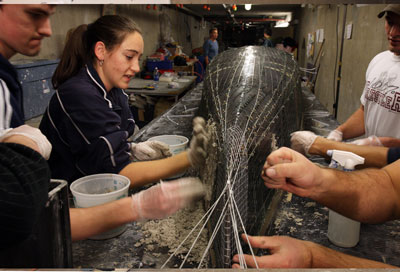After testing 27 batches of concrete mixtures, the University of Nevada, Reno National Champion concrete canoe team poured the concrete Saturday on a new boat design in preparation for the upcoming regional competition. The University is hosting the annual conference of the Mid-Pacific Region of the American Society of Civil Engineers April 16-18, which includes the regional canoe competition.
“This is a huge event,” Robert Coomes, conference chairman and past University concrete canoe team member said. “We have 400 engineering students from outside the area coming to Reno. It’s a great economic benefit for the community, but also a chance for undergraduates to put their skills and knowledge to the test and compete against other schools.”
The majority of conference events will be held on the campus in Reno and the canoe racing competition will be held at the Sparks Marina.
The 20 to 25 team members, led by Project Manager and senior civil engineering student Mitch Brown, have been working on the new canoe for several months using design specifications laid out in the 76 pages of rules and regulations governing the ASCE competition. The boat must be 20 feet long and no more than 31.1875 inches wide at the beam (middle). A complete set of design specifications and drawings, including concrete mixtures, dimensions, structural elements and floatation materials, are used by each of the 12 teams in the Mid-Pacific region in building their boats.
“Some of the schools use flotation materials like Styrofoam in their design, but we’ve created a mixture of concrete that is one-third the normal weight of concrete and by volume is lighter than water,” Coomes said.
The concrete “pour” is more of a sculpting of the canoe’s concrete hull as the nooks and crannies around the support structure are trowel- and hand-packed with the concrete mixture, which is not so much fluid as it is “a lot like gritty Play-Doh,” Coomes said. The less than half-inch thick, one-layer process can take as long as eight hours to complete.
As the team poured and stirred the dozen or so ingredients that goes into their custom concrete mix, Civil Engineering student Katie Bowden, a junior from Reno who has been on the team since 2007, demonstrated how to apply the right amount of mixture to the team's canoe shell. Team members lined up along the sides of the canoe and painstakingly applied the concrete, smoothed it and sculpted it to the .4 inch thickness.
The concrete will cure for 28 days in the bunker-like depths of the Harry Reid Building's Large Structures Lab and the canoe will see daylight just before the event in April when it goes up against the other boats from the Mid-pacific region. Except for the University of Nevada, Reno, all of the schools are from California.
“Our huge adversary is UC Berkeley,” Coomes said. “We have a lot on the line. We’re going to have to really bring our skills to the forefront to beat them.” The Nevada team took first place at the national event in Montreal last year and look forward to defending that title at the national competition to be held at the University of Alabama at Tuscaloosa in June.
They must place first or second at the regionals to move on to the national competition. In the past three years, they placed first twice and second once at regionals. This canoe will be used in both the regional and national competition.
Other engineering competitions held at the Mid-Pacific Conference are the Water Treatment Competition, the Steel Bridge Competition. Concrete Bowling and the Canoe Tug-of-War, less serious events, are also a part of the conference.
The Water Treatment Competition includes a scenario of a San Francisco Bay Area earthquake with sewer mains broken throughout the region. The engineering students must devise a quick, efficient system to treat and release the wastewater, which is a 10-gallon mixture of water, clay, leaves oil, rusted chicken wire, Jell-O, soil, lemon juice, ground beef and creamed corn. The event is scheduled to be held in front of the Joe Crowley Student Union.
The Steel Bridge Competition scenario challenges the engineering students to replace a 100-year-old bridge that is vital to the region’s economy, so it must be done quickly and to rigorous design, environmental and visual specifications. The competition will be held in the Lawlor Events Center. All of the competitions are open to the public.
The conference is supported by donations and sponsorships and Coomes said they need to continue fundraising for the event. Those interested in helping may contact Coomes at (775) 721-2714.
















